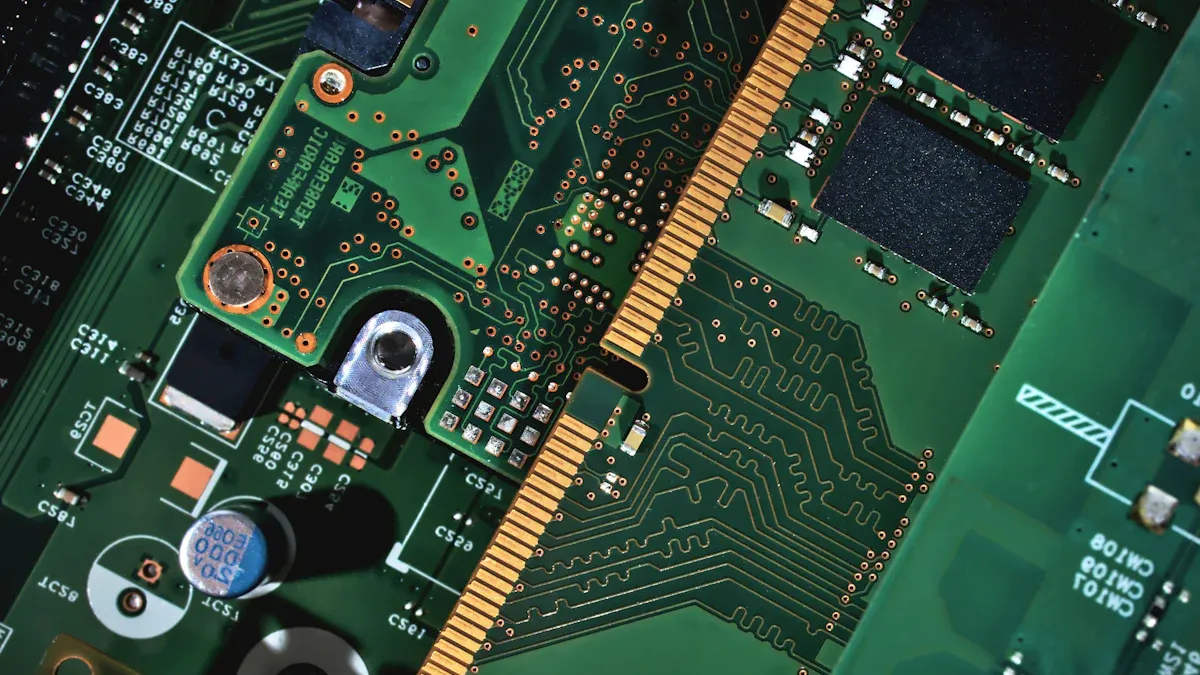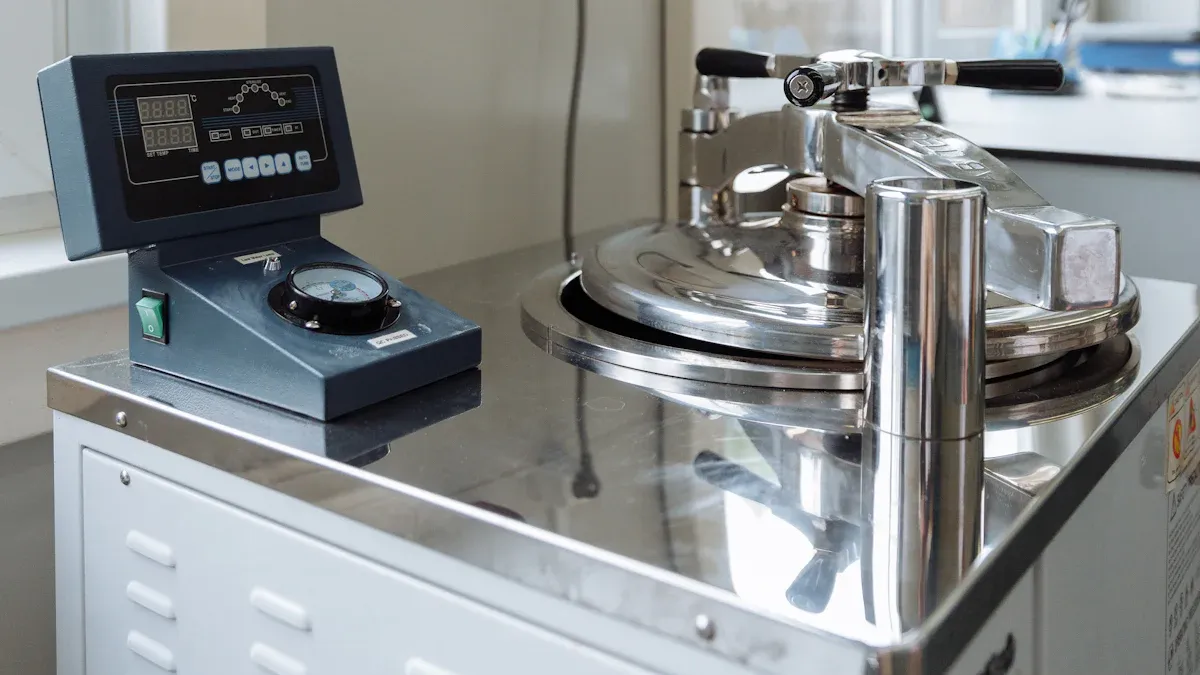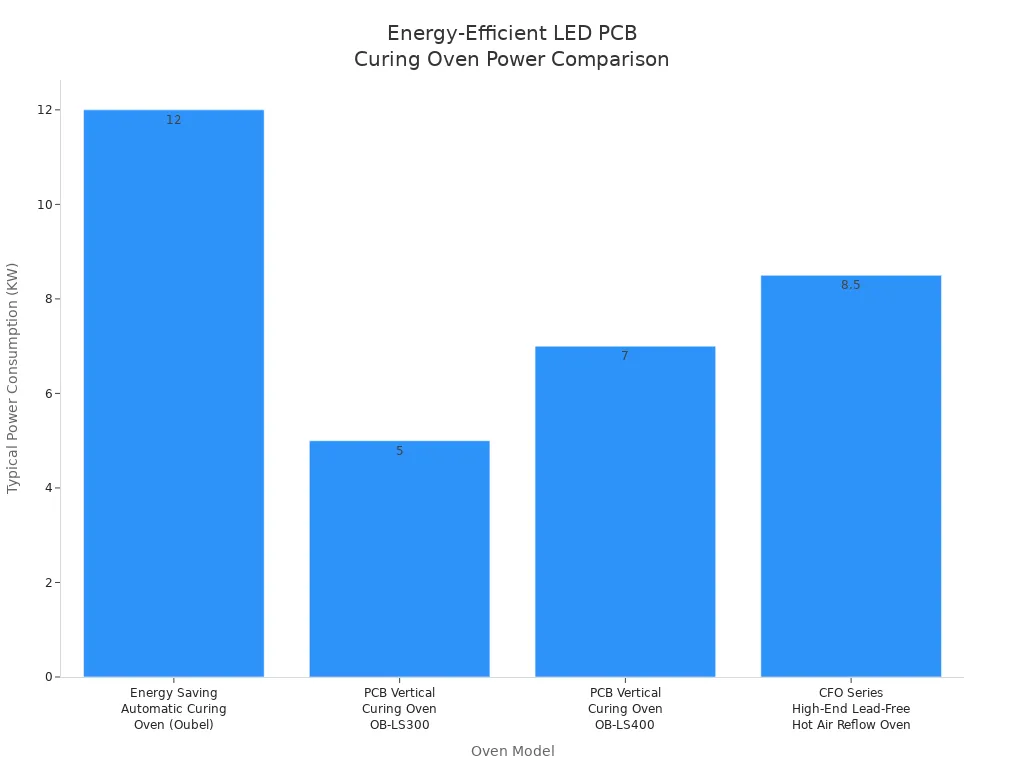
When you select a curing oven for LED PCB manufacturing, focus on several critical factors. You want the right oven type, precise temperature and wavelength control, strong intensity, uniform heat distribution, the right size, and reliable safety features. These decisions directly affect your product’s quality, efficiency, and long-term reliability. Matching the curing method to your coatings and production scale ensures fast curing, energy savings, and consistent results. As you explore options, consider your unique production needs and technical requirements.
Key Takeaways
-
Choose the right oven type based on your production volume and product shapes to ensure efficient and consistent curing.
-
Control temperature and wavelength precisely to avoid damage and achieve strong, even curing of adhesives and coatings.
-
Ensure uniform intensity across the curing area to prevent weak spots and improve product quality.
-
Prioritize safety features like UV shields and automatic shutoffs to protect operators and maintain compliance.
-
Plan for future growth by selecting flexible ovens that can scale with your production needs and save costs later.
Curing Oven Basics

A curing oven plays a vital role in LED PCB manufacturing. You use it to apply controlled heat and precise temperature profiles, which cure adhesives and coatings. This process secures LED chips and other components, improves reliability, and ensures stable assembly. You also rely on the curing oven to manage thermal conditions, preventing damage to sensitive electronics and supporting efficient production.
Oven Types
You can choose from several curing oven types, each with unique operating principles and benefits. The main options include batch ovens and continuous process ovens. Batch ovens heat grouped parts with manual loading and unloading. Continuous process ovens use powered conveyors for steady, automated movement and curing. The table below highlights key differences:
|
Feature |
Batch Ovens |
Continuous Process Ovens |
|---|---|---|
|
Operating Principle |
Intermittent heating of batches; manual handling. |
Automated, steady movement; continuous processing. |
|
Material Handling |
Manual loading/unloading. |
Automated conveyors. |
|
Flexibility |
Suits varied shapes and prototyping. |
Optimized for standardized, high-volume runs. |
|
Cost |
Lower initial investment. |
Higher cost due to automation. |
|
Temperature Control |
Precise during dwell time; may have uneven zones. |
Uniform curing with continuous airflow. |
You also find IR ovens, UV ovens, UV LED ovens, and lab ovens. IR ovens use infrared heat, while UV ovens use ultraviolet light. UV LED ovens offer energy efficiency and longer lamp life. Lab ovens suit small-scale testing and prototyping.
Tip: Match the oven type to your application. For example, use batch ovens for small runs or varied shapes, and continuous ovens for high-volume production.
UV vs IR Curing
When you compare UV and IR curing, you notice several advantages and disadvantages:
-
UV curing ovens generate low heat, protecting heat-sensitive LED PCBs.
-
UV curing works fast, often curing materials in seconds, which boosts throughput.
-
UV curing requires UV-friendly coatings, which cost more than standard coatings.
-
UV light has limited penetration, so curing depth may be restricted.
-
UV LED ovens offer energy efficiency, longer lamp life, and minimal heat output.
-
IR curing ovens use heat, which can risk thermal damage, but work with standard coatings and offer deeper penetration.
UV curing provides consistent results, improved durability, and environmental benefits due to low VOCs. However, you must consider coating costs and penetration limits.
Key Features
When you select a curing oven, focus on features that support quality and efficiency:
-
Multiple heating zones with zone control valves for uniform temperature.
-
Programmable temperature profiles for tailored curing.
-
Accurate sensors for precise control.
-
Adjustable shelving for different PCB sizes.
-
Data logging and monitoring for process validation.
-
Alarms and safety features for reliable operation.
-
User-friendly interfaces for ease of use.
-
Advanced airflow and oxygen control for strict curing requirements.
-
Certifications such as ISO9001, CE, and RoHS for safety and reliability.
You should look for a curing oven with these features to ensure consistent results and protect your investment.
Selection Criteria
Temperature and Wavelength Control
You need precise temperature and wavelength control to achieve high-quality curing in LED PCB manufacturing. Accurate temperature management ensures that adhesives and coatings cure evenly and completely. If the temperature is too low, you risk incomplete curing, which weakens mechanical strength and reduces electrical insulation. If the temperature is too high, you may cause rapid curing, internal stress, or even damage to sensitive components.
-
Consistent temperature control improves curing uniformity and product reliability.
-
Proper temperature settings help potting materials flow into tiny gaps, fully protecting LED chips.
-
Maintaining the right temperature range prevents defects like cracking, deformation, or incomplete curing.
-
Stable temperature also helps eliminate bubbles, which can extend the lifespan of your LED PCBs.
Wavelength control is just as important, especially when using UV or UV LED curing ovens. You must match the emission wavelength of your curing oven to the absorption spectrum of the adhesives or coatings. For example, UV LED systems often use 365 nm or 395 nm wavelengths. When you select the right wavelength, you ensure efficient curing, proper depth, and strong bonding. This approach also allows you to cure heat-sensitive materials without causing warping or adhesion failure, since UV LED curing produces minimal heat.
Tip: Always check the technical data sheets for your coatings and adhesives to confirm the optimal temperature and wavelength settings for your curing oven.
Intensity and Uniformity
You should pay close attention to the intensity and uniformity of the curing process. Uniform UV intensity across the entire curing area ensures that every part of your PCB receives the same amount of energy. If the intensity varies, you may see uneven curing, which leads to weak spots or inconsistent performance.
-
Uniform intensity supports consistent curing output and improves manufacturing yields.
-
Proper calibration of your curing oven guarantees that the output matches the requirements of your coating materials.
-
Matching the oven’s intensity to the photoinitiators in your adhesives or coatings ensures effective curing, influencing depth, surface hardness, and overall quality.
You can use radiometers or built-in sensors to monitor and adjust intensity, making sure your process stays stable and repeatable.
Size and Portability
You need to consider the size and portability of your curing oven to fit your production environment. The oven must accommodate the dimensions of your LED PCBs and fit within your available workspace. If you work in a facility with multiple production lines or limited space, a compact and portable curing oven offers several advantages:
-
You can move portable ovens between different workstations or locations, increasing flexibility.
-
Lightweight and compact designs allow you to deploy ovens in confined spaces or remote areas.
-
Battery-operated or easily transportable ovens support operations in places with limited power access.
-
Quick setup and easy transport help you adapt to changing production needs and improve workflow efficiency.
Choosing the right size and portability features ensures that your curing oven supports both current and future manufacturing requirements.
Safety Features
You must prioritize safety features when selecting a curing oven. International standards require several key protections to keep operators safe and maintain compliance:
-
CE certification confirms that the oven meets global safety standards.
-
Safety shutters at the entrance and exit prevent exposure to hazardous UV light.
-
Microprocessor PLC controllers manage speed, shutter operation, and UV on/off functions.
-
Conveyor jam detection systems automatically shut down the UV source to prevent accidents.
Intelligent door protection systems further enhance safety. These systems use mechanical door lock sensors and interlock doors to stop the oven immediately if someone opens the front or rear doors. Adjustable metal door covers reduce UV light leakage, protecting operators from accidental exposure. These features work together to prevent both UV exposure and mechanical hazards, creating a safer work environment.
Note: Always train your staff on proper oven operation and safety protocols to maximize protection.
Nitrogen Atmosphere
You should consider a curing oven with nitrogen atmosphere capability if you want to prevent oxidation during the curing process. Maintaining a nitrogen-rich environment with low oxygen levels reduces the risk of oxidation on sensitive PCB finishes, such as nickel-gold surfaces. This approach is especially important for fine-pitch LED packages, where oxidation can compromise solder joints and overall product quality.
Advanced manufacturing facilities often use convection reflow systems with nitrogen to minimize oxidation and improve solder joint reliability. The same principle applies to curing ovens: a nitrogen atmosphere helps maintain the integrity of coatings and soldered connections by preventing unwanted chemical reactions during heat exposure.
Using a nitrogen atmosphere in your curing oven can significantly enhance the durability and performance of your LED PCBs.
Curing Oven Checklist
Selecting the ideal curing oven for your LED PCB manufacturing line necessitates a thorough evaluation of several key factors. Use this checklist to guide your decision and ensure your equipment matches your production needs.
Material Compatibility
Start by confirming that your curing oven is compatible with the materials you use. Some adhesives and coatings require specific wavelengths or heating methods. For example, UV-curable coatings need ovens with the correct UV spectrum, while sensitive components may benefit from nitrogen or vacuum support. Always check the technical data sheets for your materials and match them with the oven’s capabilities. This step prevents incomplete curing and ensures strong, reliable bonds.
Production Volume
Your production scale directly influences the type of curing oven you need:
-
High-volume lines benefit from conveyor-based ovens, which provide continuous throughput and support automation.
-
Batch ovens suit small-batch or laboratory operations, offering a compact footprint and controlled environment.
-
Power output matters: high-power ovens handle thick films and fast line speeds, while low-power models fit thin films and delicate substrates.
-
Robot-mounted or handheld ovens can support specialized or scalable tasks.
Tip: Align your oven’s configuration and power with your expected production volume to maximize efficiency and product quality.
Energy Efficiency
Energy costs can add up quickly in manufacturing. Compare models for their energy-saving features and typical power consumption. The table below highlights several energy-efficient curing oven models:
|
Model |
Power Consumption (Typical) |
Description/Notes |
|---|---|---|
|
Energy Saving Automatic Curing Oven (Shenzhen Oubel) |
12KW |
Adjustable curing time, max temp 250℃ |
|
PCB Vertical Curing Oven OB-LS300 |
4-6KW (normal working) |
Six heating zones, high thermal efficiency |
|
PCB Vertical Curing Oven OB-LS400 |
6-8KW (normal working) |
Larger capacity, energy-efficient with PID control |
|
CFO Series High-End Lead-Free Hot Air Reflow Oven |
7.5-9.5KW |
Advanced thermal control, lead-free soldering |

Look for ovens with programmable controls, multiple heating zones, and high thermal efficiency to reduce operational costs.
Maintenance Needs
Regular maintenance keeps your curing oven running smoothly and extends its lifespan. Maintenance requirements vary by oven type:
|
Oven Type |
Lifespan (hours) |
Heating Time |
On/Off Flexibility |
Maintenance Requirements |
|---|---|---|---|---|
|
UV LED Lamps |
~20,000 |
None (microseconds) |
High (on/off as needed) |
Minimal; no replacement needed for years |
|
Mercury Lamps |
600 to 2,000 |
Several minutes |
Low (cycling damages the lamp) |
Frequent replacement; reflector cleaning needed |
Lab ovens require regular calibration of sensors and airflow systems to maintain stable conditions. Always choose a model with strong technical support and warranty coverage to minimize downtime.
A well-maintained curing oven ensures consistent results and protects your investment.
Mistakes to Avoid
When you select and operate equipment for LED PCB manufacturing, you can easily overlook critical details. Avoiding common mistakes helps you maintain high product quality and reliable production.
Overlooking Uniformity
Uniformity in heat or UV exposure is essential. If you ignore this, you risk uneven curing. Some areas of your PCB may receive too much or too little energy. This leads to weak bonds, incomplete curing, or even visible defects. Always check that your oven delivers consistent intensity across the entire working area. Use sensors or radiometers to verify uniformity during setup and routine checks.
Ignoring Calibration
Skipping calibration creates serious risks for your process. You may see:
-
Uneven heating that causes soldering defects.
-
Overheating of sensitive components, which shortens their lifespan.
-
Poor solder joints and process instability.
-
Inaccurate temperature profiles that damage components.
-
Reduced repeatability if you only use standard test boards instead of actual products.
-
Inadequate process control when you ignore board-specific factors like size, copper content, or component layout.
You should always calibrate with real boards and place thermocouples at critical points. Run thermal profiles for each assembly type. Use stable fixtures and check your oven daily or weekly to keep performance consistent.
Underestimating Safety
You must never ignore safety features. Failing to use proper shielding or interlocks exposes operators to UV light or high temperatures. This can cause injuries or equipment damage. Always train your team on safe operation. Make sure all safety systems work before starting production. Regularly inspect doors, shutters, and emergency stops.
Safety is not optional—protect your team and your investment by making it a top priority.
Neglecting Future Needs
You should plan for future growth. If you choose equipment that only meets your current needs, you may face costly upgrades later. Consider your expected production volume, new product types, and possible automation. Select flexible systems that can scale with your business. This approach saves time and money as your operation expands.
-
You should focus on oven type, temperature control, intensity, and safety when choosing equipment for LED PCB manufacturing.
-
Align oven features with your production goals and quality standards.
-
Consult suppliers or industry experts to find the best fit for your needs.
-
Evaluate your current process and consider arranging a demo before making a final decision.
Taking these steps helps you improve product reliability and streamline your workflow.
FAQ
What is the difference between UV and IR curing ovens?
UV curing ovens use ultraviolet light to cure coatings quickly and protect heat-sensitive PCBs. IR curing ovens use infrared heat, which penetrates deeper but can risk thermal damage. You should match the oven type to your coating and production needs.
How do I know which oven size fits my production line?
Measure your largest PCB and check your workspace. Choose an oven that fits your board dimensions and allows easy movement. Portable ovens work well for small spaces or flexible setups. You can use a table to compare oven sizes:
|
Oven Type |
Max PCB Size |
Footprint |
|---|---|---|
|
Batch |
300mm x 300mm |
Small |
|
Conveyor |
500mm x 400mm |
Medium/Large |
Why is a nitrogen atmosphere important for curing ovens?
Nitrogen atmosphere prevents oxidation during curing. You protect sensitive finishes and solder joints by reducing oxygen exposure. This feature improves reliability and extends the lifespan of your LED PCBs.
How often should I calibrate my curing oven?
You should calibrate your curing oven weekly or after any major maintenance. Use real boards and place sensors at critical points. Regular calibration ensures consistent temperature and intensity, which leads to reliable curing results.
